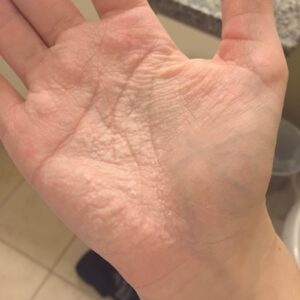Cure4CF Update
What is Aquagenic wrinkling and what does it mean in CF?
Last year one of our ambassadors contacted me curious about aquagenic wrinkling they had observed. I had never heard of the condition and was curious to learn more.
 Aquagenic wrinkling is rare but commonly occurs in people with cystic fibrosis or genetic carriers. This is more than the winkling you may have experienced on immersing your hands in water for a few minutes. This condition presents as the development of rapid and excessive wrinkling and swelling on the surfaces of the palms of the hands (see the image on the right). It can also be experienced with transient raised areas of skin which are called papules, and these can be white or yellow in colour and many people also experience pain.
Aquagenic wrinkling is rare but commonly occurs in people with cystic fibrosis or genetic carriers. This is more than the winkling you may have experienced on immersing your hands in water for a few minutes. This condition presents as the development of rapid and excessive wrinkling and swelling on the surfaces of the palms of the hands (see the image on the right). It can also be experienced with transient raised areas of skin which are called papules, and these can be white or yellow in colour and many people also experience pain.
A clinical picture report published in the Lancet in 2014 reported two cases of people in their 20s. Both had presented for dermatology assessment, and both developed significant swelling and wrinkling on the skin of the palms of their hands within 3 minutes of being in contact with water. On further investigation, one was found to be a CF carrier and the other was found to have a diagnosis of non-classical cystic fibrosis. The picture below from the article shows the hands after the right hand had been immersed in water for 3 minutes – you may notice there is wrinkling on the palm and fingertips. You can read the full report here.
Research findings suggests that this condition is seen in around 25% of CF carriers and somewhere between 40 and 80% of people with CF. The exact reason for this increased swelling in people with CF and CF carriers is unclear, but it is thought to be due to the defective CFTR protein. There is thought to be increased movement of liquid to the skin resulting in the swelling. Other researchers have suggested it could also be due to dysfunction of channels involved in water transport to the skin cells.
One study published in 2021 studied 250 people, 100 with CF, 100 without CF and 50 parents of people with CF. The participants had their aquagenic wrinkling assessed after varying times following a brief immersion in water. The rate of a positive test after 3 minutes of immersion in water was 68% for those with CF, 8% for the parents and 0% for those who did not have CF. Following a 7-minute immersion time, all the CF participants were positive for wrinkles with 32% of parents and 7% of controls. The authors go on to suggest that this kind of test might be a helpful screening test for someone with CF. You can read more about this study here.
While this kind of screening test could not replace the sweat test and DNA analysis, it may be helpful in areas where these tests cannot be accessed as an early screening tool and is low cost.
Jodie Simpson
CF Research and Development Lead
